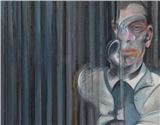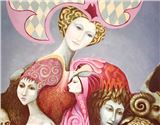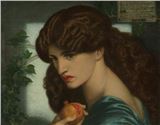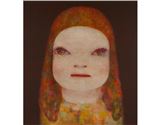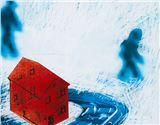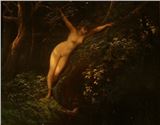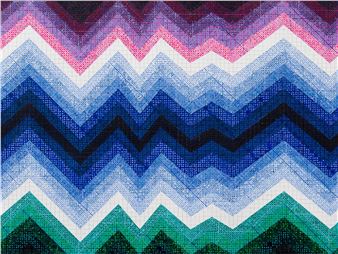Group Exhibition: Fusiform Gyrus
вҖҳAt first I thought it was about food. Fussy politics or lint cake baked in Greek week. We are all in greet week, are we not? Goods baked in no goods. But certainly multiplications. Certainly it was moving; I saw it, a usi-ff-form, from the corner of my eye. Which eye?вҖҷ вҖ“ the poet Uljana Wolf dispatches from the left of the gallery floor.
Ruffs Orgy I Sum and Frigs Fumy Sour stand next to her. The first sounds like birds in Buenos Aires and the second moves like a trail of light. They have more in common than being anagrams of this group exhibition of sculpture: their properties belong to many different orders of life, including their own selves, yet their favourite mode of being is moving through those orders. вҖҳGroupвҖҷ stands for the totality of the senses, вҖҳsculptureвҖҷ dreams of plasticity at large. This sensual plasticity applies to time, subjectivity, the body, and also to the face.
The idea of a face that exceeds its portrait and disappears into its moving parts is key. The title of each work is an anagram of the title of the exhibition, вҖҳFusiform GyrusвҖҷ, which is the name of a particular area of the brain: the lobe that neuroscientists attribute with facial recognition facilities. Thus each work is a cognitive and spatial version of the exhibition itself (and vice versa). After this exhibition is over, the titles may mutate or change in their significance.
Meanwhile, one can walk through the expanded laser sculpture of Elena NarbutaitД—; it hovers above the ground like one of the sculptures in Koenraad DedobbeleerвҖҷs room. In fact, these two rooms open up like a double solo show; how can we trust one identity? Split between genres and volumes these scenes smell of peanuts and pistachio.
Scent enters the conversation where a breakdown in the relationship between parts and the whole is one of the ways to explain face-blindness. If scent вҖ“ and the nose вҖ“ belongs to an interior recognition rather than that of the face, there is a chance we may not recognise the person whose nose it is; we may exit the interior through a new door that opens a new trail of passage rather than separating inside from outside.
An exhibition as hologram brings this spatial conceptual logic into a continuous loop. It also refers to the early history of Lisson Gallery, when holograms of Margaret Benyon were displayed in laser light.
вҖҳI relate face-blindness to de-personalisation, to stripping the subject down to an object, inanimate object, abstraction and therefore looking at it through a different dimension.вҖҷ вҖ“ Ola Vasiljeva writes. Her work takes you along the countless dimensions and versions of the same figure of thought. There is a synesthetic quality in almost everything (even her concepts). A fully dressed coffee-table turns into Miet Warlop. During a performance at the opening of the show she will find the history of sculpture in her blood and liquify it. In Phanos KyriacouвҖҷs collection, pottery rejects come across as poetry. Rosalind Nashashibi blinds objects of desire with wit, with their own power to enchant.
вҖҳAnything that bends light is a lens. All sorts of things bend light. Anything with mass. You do. I do. The Earth is a lens. My slippers are too.вҖҷ вҖ“ claims Aditya Mandayam, who travelled around and across the Earth to meet himself in various guises of unrecognisability. One of these guises is a yoghurt sculpture composed of three different types of yoghurt.
Alex Bailey shrugs and tells a different story on a similar matter (or substance). Before Gintaras Didziapetris became an object of archaeology of the future, he took photos of a city on the other side of the Hudson River.
Phanos KyriacouвҖҷs sculpture of light is not so heavy вҖ“ almost the same weight as a hallway furniture piece by Liudvikas Buklys, which is based on the measurements of the indica cannabis plant. Sasha Suhareva makes her own mirrors based on ancient formulas that refract abstraction and narcissism. As one approaches, they dim.
A robot reprogrammed by Liudvikas Buklys wanders like a character from an infinite screensaver, occasionally shouting out names people have given to it. One can hear it in the background of the conversation that Eduardo Costa is conducting in the language of the birds that land every day on his balcony in Buenos Aires.
From Uruguay there are two canvases that Eduardo Costa produced in 1987 as a response to FontanaвҖҷs cuts. And a вҖҳlife-sizeвҖҷ Pinocchio (or Burattino) has been crafted by a carpenter at the gallery, as requested by Darius MikЕЎys.
Elizabeth Hoak-Doering has taken an artworkвҖҷs point of view to write a guide to the exhibition as well as to draw the artwork for the poster. A limited edition of the catalogue of the exhibition will be released in the form of home-made lenses by Aditya Mandayam.
вҖҳAnna OвҖҷs face-blindness extended to flowers, she was able to see a rose (nose) but never the whole bouquet, hers was therefore trans-species blindness and only poetry could catch up with her later: Kurt SchwittersвҖҷs Anna Blume poem is actually a poem about Alice and Anna debating how practical it would be to have a face where things could be switched up a bit, otherwise how would you recognise anybody?вҖҷ вҖ“ Uljana Wolf continues.
Notes to editors
About the curator
Raimundas MalaЕЎauskas, born in Vilnius, is a curator and writer. From 1995 to 2006 he worked at the Contemporary Art Centre in Vilnius, where he produced the first two seasons of the weekly television show вҖҳCAC TVвҖҷ, an experimental merger of commercial television and contemporary art that ran under the slogan вҖҳEvery program is a pilot. Every program is the final episode.вҖҷ He curated вҖҳBlack Market WorldsвҖҷ, the IX Baltic Triennial, at CAC Vilnius in 2005.
From 2007 to 2008 MalaЕЎauskas was a visiting curator at California College of the Arts, San Francisco, and, until 2010, a curator-at-large of Artists Space, New York. In 2007 he co-wrote the libretto Gellar Door, an opera by Loris GrГ©aud produced in Paris. He has curated the exhibitions вҖҳSculpture of the Space AgeвҖҷ, David Roberts Art Foundation, London (2009); вҖҳInto the Belly of a DoveвҖҷ, Museo Rufino Tamayo, Mexico City (2010); and вҖҳRepetition IslandвҖҷ, Centre Georges Pompidou, Paris (2010).
Recently he worked as one of the agents of dOCUMENTA 13. He is currently curating вҖҳoOвҖҷ, an exhibition for the Lithuanian and Cypriot pavilions at the 55th Venice Biennale.
вҖҳAt first I thought it was about food. Fussy politics or lint cake baked in Greek week. We are all in greet week, are we not? Goods baked in no goods. But certainly multiplications. Certainly it was moving; I saw it, a usi-ff-form, from the corner of my eye. Which eye?вҖҷ вҖ“ the poet Uljana Wolf dispatches from the left of the gallery floor.
Ruffs Orgy I Sum and Frigs Fumy Sour stand next to her. The first sounds like birds in Buenos Aires and the second moves like a trail of light. They have more in common than being anagrams of this group exhibition of sculpture: their properties belong to many different orders of life, including their own selves, yet their favourite mode of being is moving through those orders. вҖҳGroupвҖҷ stands for the totality of the senses, вҖҳsculptureвҖҷ dreams of plasticity at large. This sensual plasticity applies to time, subjectivity, the body, and also to the face.
The idea of a face that exceeds its portrait and disappears into its moving parts is key. The title of each work is an anagram of the title of the exhibition, вҖҳFusiform GyrusвҖҷ, which is the name of a particular area of the brain: the lobe that neuroscientists attribute with facial recognition facilities. Thus each work is a cognitive and spatial version of the exhibition itself (and vice versa). After this exhibition is over, the titles may mutate or change in their significance.
Meanwhile, one can walk through the expanded laser sculpture of Elena NarbutaitД—; it hovers above the ground like one of the sculptures in Koenraad DedobbeleerвҖҷs room. In fact, these two rooms open up like a double solo show; how can we trust one identity? Split between genres and volumes these scenes smell of peanuts and pistachio.
Scent enters the conversation where a breakdown in the relationship between parts and the whole is one of the ways to explain face-blindness. If scent вҖ“ and the nose вҖ“ belongs to an interior recognition rather than that of the face, there is a chance we may not recognise the person whose nose it is; we may exit the interior through a new door that opens a new trail of passage rather than separating inside from outside.
An exhibition as hologram brings this spatial conceptual logic into a continuous loop. It also refers to the early history of Lisson Gallery, when holograms of Margaret Benyon were displayed in laser light.
вҖҳI relate face-blindness to de-personalisation, to stripping the subject down to an object, inanimate object, abstraction and therefore looking at it through a different dimension.вҖҷ вҖ“ Ola Vasiljeva writes. Her work takes you along the countless dimensions and versions of the same figure of thought. There is a synesthetic quality in almost everything (even her concepts). A fully dressed coffee-table turns into Miet Warlop. During a performance at the opening of the show she will find the history of sculpture in her blood and liquify it. In Phanos KyriacouвҖҷs collection, pottery rejects come across as poetry. Rosalind Nashashibi blinds objects of desire with wit, with their own power to enchant.
вҖҳAnything that bends light is a lens. All sorts of things bend light. Anything with mass. You do. I do. The Earth is a lens. My slippers are too.вҖҷ вҖ“ claims Aditya Mandayam, who travelled around and across the Earth to meet himself in various guises of unrecognisability. One of these guises is a yoghurt sculpture composed of three different types of yoghurt.
Alex Bailey shrugs and tells a different story on a similar matter (or substance). Before Gintaras Didziapetris became an object of archaeology of the future, he took photos of a city on the other side of the Hudson River.
Phanos KyriacouвҖҷs sculpture of light is not so heavy вҖ“ almost the same weight as a hallway furniture piece by Liudvikas Buklys, which is based on the measurements of the indica cannabis plant. Sasha Suhareva makes her own mirrors based on ancient formulas that refract abstraction and narcissism. As one approaches, they dim.
A robot reprogrammed by Liudvikas Buklys wanders like a character from an infinite screensaver, occasionally shouting out names people have given to it. One can hear it in the background of the conversation that Eduardo Costa is conducting in the language of the birds that land every day on his balcony in Buenos Aires.
From Uruguay there are two canvases that Eduardo Costa produced in 1987 as a response to FontanaвҖҷs cuts. And a вҖҳlife-sizeвҖҷ Pinocchio (or Burattino) has been crafted by a carpenter at the gallery, as requested by Darius MikЕЎys.
Elizabeth Hoak-Doering has taken an artworkвҖҷs point of view to write a guide to the exhibition as well as to draw the artwork for the poster. A limited edition of the catalogue of the exhibition will be released in the form of home-made lenses by Aditya Mandayam.
вҖҳAnna OвҖҷs face-blindness extended to flowers, she was able to see a rose (nose) but never the whole bouquet, hers was therefore trans-species blindness and only poetry could catch up with her later: Kurt SchwittersвҖҷs Anna Blume poem is actually a poem about Alice and Anna debating how practical it would be to have a face where things could be switched up a bit, otherwise how would you recognise anybody?вҖҷ вҖ“ Uljana Wolf continues.
Notes to editors
About the curator
Raimundas MalaЕЎauskas, born in Vilnius, is a curator and writer. From 1995 to 2006 he worked at the Contemporary Art Centre in Vilnius, where he produced the first two seasons of the weekly television show вҖҳCAC TVвҖҷ, an experimental merger of commercial television and contemporary art that ran under the slogan вҖҳEvery program is a pilot. Every program is the final episode.вҖҷ He curated вҖҳBlack Market WorldsвҖҷ, the IX Baltic Triennial, at CAC Vilnius in 2005.
From 2007 to 2008 MalaЕЎauskas was a visiting curator at California College of the Arts, San Francisco, and, until 2010, a curator-at-large of Artists Space, New York. In 2007 he co-wrote the libretto Gellar Door, an opera by Loris GrГ©aud produced in Paris. He has curated the exhibitions вҖҳSculpture of the Space AgeвҖҷ, David Roberts Art Foundation, London (2009); вҖҳInto the Belly of a DoveвҖҷ, Museo Rufino Tamayo, Mexico City (2010); and вҖҳRepetition IslandвҖҷ, Centre Georges Pompidou, Paris (2010).
Recently he worked as one of the agents of dOCUMENTA 13. He is currently curating вҖҳoOвҖҷ, an exhibition for the Lithuanian and Cypriot pavilions at the 55th Venice Biennale.
Contact details


 ARTISTS
ARTISTS
